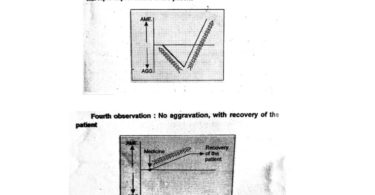Author: Prof. (Dr.) Goutam Das M. D. (Homoeopathy)
Assist by: Dr. Annu Patel B.H.M.S.
[Abstract: This article deals with the understanding of the concept of miasm, on the light of the teaching of our Organon of Medicine & Homoeopathic Philosophy.]
Keywords: Miasm-origin of concept-definition-types-classification-affinity at a glance.
Abbreviation: eg = example; i.e. = that is.
Origin of concept:
It required about twelve years for Dr. Hahnemann to discover and gather together the evidence upon which he came to his conclusions:
- That, epilepsy, insanity, cancer, Bright’s disease and every other case of so-called diseases are only one of the result of disease, and never appears twice alike and have all had a beginning and one beginning.
- That, the short acting apsoric medicines were able to cure only a single manifestation of disease, a group of symptoms or they would relieve for a time and then the symptoms would come back; although he had followed up the treatment to the best of his knowledge.
- That, the individual case has been steadily progressing and have not struck at the root of the trouble.
- That, the state which Dr. Hahnemann used the word “Miasm” in the sense of ‘Chronic Syndrome’.
Definition: A miasm is an invisible polluting substance, which one gains entrance into the system of a living human being, and over-powers the vital-dynamis, pollutes the person as a whole in such a way, that it leaves behind a permanent stigma or dyscrasia, which if not completely eradicated with the help of suitable anti-miasmatic treatment, will persist through-out the life of the patient and may be transmitted through generation after generation. [1]
Types of Miasm: Miasms are two types – acute and chronic.
Acute Miasm: This is a dynamic disease producing power, causing acute, specific, infectious or epidemic diseases, having almost fixed manifestations.
Dr. J.T. Kent says, “An acute miasm is one that comes upon the economy, passes through its regular prodromal period, longer or shorter, and has its period of progress and period of decline and in which there is tendency to recovery.”
Acute miasms are two types – recurrent and non-recurrent.
- Recurrent Acute Miasm: These are recurs in the same manner. It can keep recurring in the same manner again and again. The recurrence may also be seasonal. For examples; plague Levant, Asiatic cholera, yellow fever of the sea cost etc.
- Non-recurrent or Fixed Miasm: These are occurs once in life-time of a person with almost in all fixed in its manifestations. For examples; small pox, whooping cough, measles, bright red scarlet fever etc.
Chronic Miasm:
These are the fundamental cause of chronic diseases, bring the tendency to suffer from chronic diseases, and make a person prone to suffer from acute diseases also. They are three – Psora, Syphilis and Sycosis.
Difference between Acute and Chronic Miasm:
| Acute Miasm: | Chronic Miasm: |
| Refers to dynamic disease producing power causing epidemic type of acute diseases. | Produces true chronic diseases.
Predispose the person to be affected by acute diseases. |
| Has a distinct period of progress and decline i.e. a predetermined course.
Left to itself it result either in recovery or death. |
Has the tendency to carry on with the patient and left does not result in recovery, go through generation after generation. |
| Two types:
Recurring and Non-recurring. |
Three types:
Psora, Syphilis and Sycosis. |
Classification of Miasm by Dr. S.P. Dey:
ACUTE MIASM:
- Acute miasms, for specific diseases; eg. Miasm of Cholera, Pneumonia, Diphtheria etc.
- Fixed miasms; eg. Miasm of Whooping cough, Small-pox etc.
- Half-spiritual miasm; eg. Miasm of Measles, Chicken-pox, Scarlet fever etc.
HALF-ACUTE MIASM: eg. Miasm of Hydrophobia or Rabies. It takes a long time for the miasm to completely develop in the system, sometimes few months or years after the bite of a mad dog. But, when develop; the patient suffers as like an acute disease and quickly dies.
CHRONIC MIASM:
- Psoric miasm, as half-spiritual miasm produce pathology of Psora.
- Syphilitic miasm, produce pathology of Syphilis.
- Sycotic miasm, produce pathology of Sycosis.
- Drug miasm, produce pathology of Artifical Chronic Disease.
- Accessary miasm of Cow-pox vaccine produce pathology of Vaccinosis.
Spiritual Sickness:
False thinking and evil willing; which are manifested by the feeling of dissatisfaction, due to false thinking as ‘separate feeling from the Divinity’,’ poverty filling’,’ un-holy feeling’,’ feelings himself as physical body’, produce a state of uncontrolled desire for taking food eating and drinking or for everything and finally develops pathology of Psora.
Psora:
Uncontrolled desires, manifested by abnormal physiological action in the level of functional disturbances may increase or decrease, having affinity to Gastro Intestinal Tract, Skin, Circulatory system as a whole etc.
Syphilis:
Destruction take place from the very beginning; manifested by abnormal physiological action in the level of soft tissue destruction in organic level as open-ulcer with always decreasing the function, having affinity to Nervous system, sensory organs like brain, eye, ear, nose, tongue, skin etc.
Sycosis:
Infiltration and lack of coordination take place from the very beginning, manifested by abnormal physiological action may increase or decrease, in the organic level; like pseudo-ulcer as if heal, having affinity to joints, pelvic organs, urine, heart as a whole, as colic or spasmodic pain etc.
Reference:
1) Boericke W, Organon of Medicine; S.Hahnemann, translated by R.E.Dudgen; Indian edition, Calcutta, Roy Publishing House, 196
2) Hahnemann Dr. Samual, The Chronic Diseases, Their Peculiar Nature and Their Homoeopathic Cure; B. Jain Publication (P) Ltd., 1, Reprint Edition: 1998; BOOK CODE: B-2266
3) Dey S.P., Essentials of Principles and Practice of Homoeopathy; Published by: Dr. Mrs. Sabita Rani Dey, CJ-325, Sector II, Bidhan Nagar, Calcutta – 700091; November 2000 [1, 2]
4) Kent JT, Lectures on Homoeopathic Philosophy; Memorial edition, B.Jain Publishers Pvt. Ltd., New Delhi, 1990[3]
About Author:
Prof. (Dr.) Goutam Das M.D. (Homoeopathy)
Dept. of Organon of Medicine, AJSHMC&RI, Mehsana, (Gujarat)
Faculty & Examiner (U.G. & P.G.), H.N.G. University, Patan, (Gujarat)
Ex. Academic Director & Principal In-Charge, NHMCH&RC, Agra (U.P.)
Ex. Examiner, Homoeopathy University, Jaipur, (Rajasthan)
Ex. Faculty & Examiner (U.G. & P.G.), Dr.B.R.A.University, Agra, (U.P.)
Ex. Faculty & Examiner JRN RVHMC, Deemed to be University, Udaipur, (Rajasthan)
Ex. Senior House Physician, PCHC&H, Kolkata (W.B.)
Assist by: Dr. Annu Patel B.H.M.S.
Board of Homoeopathic Medicine, Lucknow, Dept. of AYUSH, Govt. of U.P., & Dr.B.R.A. University, Agra (U.P.)
Ex. House Physician, JRN RVHMC, Deemed to be University, Udaipur, (Rajasthan)





